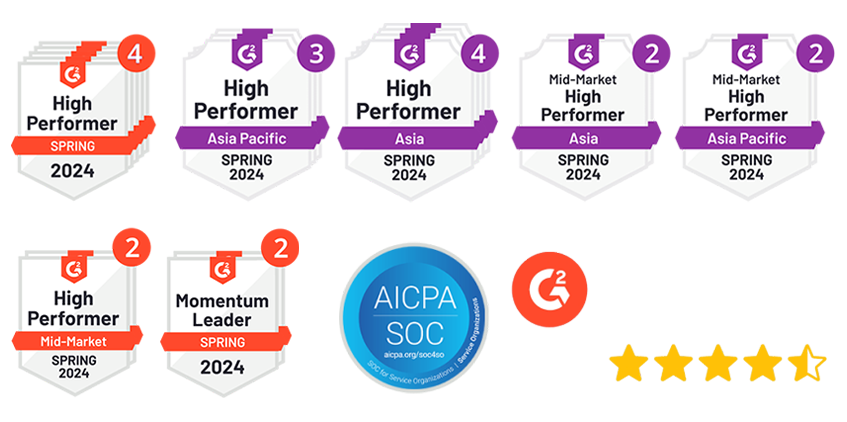Customer service teams face mounting pressure from rising expectations and limited resources. Conversational AI has become a critical solution, with 56% of companies recognizing its significant impact on operations. AI virtual agents represent the most practical approach to addressing these challenges while maintaining service quality.
The numbers tell a compelling story. Gartner estimates that 40% of enterprise applications will use conversational AI by 2023—up from just 5% today. Companies implementing virtual agents have reduced call volumes by over 50,000 calls annually, while chatbots are expected to generate $112 billion in retail revenue this year.
AI virtual agents solve more than cost concerns. They provide continuous support across all time zones and business hours, directly addressing the 67% of companies that prioritize personalization. When routine inquiries are handled automatically, your team can focus on complex issues requiring human expertise.
Customer expectations continue to evolve rapidly. The question isn’t whether you should implement AI virtual agents, but how quickly you can deploy them to remain competitive in 2025. This guide covers everything you need to know about implementing this essential technology and improving your customer service operations.
What are AI Virtual Agents and How Do They Work?
Image Source: Phaedra Solutions
AI virtual agents are sophisticated software systems that perform tasks with a level of autonomy that traditional tools cannot match. These systems use artificial intelligence to understand requests, learn from interactions, and make decisions based on available data.
Definition and Core Technologies
AI virtual agents are AI-powered software programs designed to interact with users, understand their requests, and provide relevant responses or actions. What sets them apart is their ability to demonstrate reasoning, planning, and memory capabilities that go beyond basic automation. These virtual agents combine multiple technologies, including natural language processing (NLP), machine learning, and automation, to create human-like conversations and assist with tasks across various environments.
The core functionality depends on effective language processing and analysis. Advanced algorithms break down user queries into structured data, allowing the system to determine intent and context. Many virtual agents also integrate with backend systems like CRM platforms to retrieve real-time data and execute transactions.
Virtual Agents vs Chatbots vs Assistants
Understanding these distinctions helps you choose the right solution for your business:
AI Virtual Agents demonstrate superior autonomy and adaptability compared to other options. They can evaluate data, recognize patterns, and decide the best course of action when executing complex tasks. This includes handling complex decision-making and coordinating across different systems, particularly in multi-agent configurations.
Chatbots operate through scripted conversations using either set rules or AI-driven responses for specific topics. They typically function with predefined decision trees or knowledge bases, focusing on basic customer inquiries and FAQs.
AI Assistants require a well-defined problem or query to begin and need continuous user input. While they understand natural language commands and use conversational AI interfaces to complete tasks, they lack the autonomy that defines true agents.
How NLP and Machine Learning Power Interactions
Natural language processing provides the foundation for virtual agents to understand human language effectively. NLP enables these systems to grasp context and subtle nuances rather than simply recognizing keywords. Through techniques like syntactic and semantic parsing, virtual agents analyze grammatical structure and meaning to identify user intent.
Machine learning enhances NLP by allowing virtual agents to improve over time. These algorithms recognize patterns in past interactions, enabling agents to make more accurate predictions and recommendations. This continuous learning process helps virtual agents refine their responses, becoming more effective with each interaction.
These technologies work together to create systems that can understand, reason, and act—delivering personalized support across multiple channels and languages.
Why AI virtual agents are essential for customer service in 2025
Customer service landscape demands have shifted dramatically. Traditional support models struggle to meet current expectations, making AI virtual agents essential tools for businesses competing in 2025.
Rising customer expectations
Customers expect personalized, real-time support across digital channels with little tolerance for delays or fragmented experiences. Poor service drives customer abandonment more than any other factor, making customer service a critical battleground for retention. Trust becomes the foundation—96% of consumers trust brands more when companies make doing business with them easy. Customer service has evolved beyond issue resolution to become a strategic advantage that directly impacts business growth.
24/7 support and instant response
AI-powered virtual agents operate continuously, providing support whenever customers need it through websites, mobile apps, or call centers. Results speak for themselves—one global camping company saw a 40% increase in customer engagement across all platforms. AI responds instantly to inquiries, dramatically reducing wait times compared to traditional support models. Virtual agents never tire, never quit, and can communicate with anyone, anywhere.
Cost efficiency and scalability
AI automation significantly reduces costs by handling routine inquiries without human intervention. IBM reports that AI-powered virtual agents can handle up to 80% of routine inquiries, cutting customer support costs by 30%. Across retail, e-commerce, banking, and healthcare, businesses saved $8 billion annually in 2022 through AI implementations. Banking and healthcare see particularly strong returns—each chatbot query handled saves approximately 4 minutes of agent time, translating to $0.50-$0.70 in operational cost savings per query.
Key Features that Make AI Virtual Agents Effective
Image Source: Kommunicate
Effective AI virtual agents depend on several core technologies working together to create intelligent customer interactions. These capabilities make the difference between basic automation and sophisticated support solutions that actually help customers.
Conversational AI and Natural Language Understanding
Natural language processing (NLP) serves as the foundation for AI virtual agents. Unlike simple keyword matching, NLP enables these systems to understand context and meaning within customer messages. The technology analyzes grammatical structure and identifies user intent, allowing agents to maintain natural conversations rather than forcing customers through rigid scripts.
This understanding creates more fluid interactions. When a customer says, “I can’t log into my account,” the system recognizes this as an authentication issue, not just keywords about accounts or logging in.
Personalization and Sentiment Analysis
AI virtual agents can tailor their responses by analyzing customer data and interaction history. Sentiment analysis takes this further by detecting emotions in customer communications, categorizing them as positive, negative, or neutral.
Organizations implementing sentiment analysis are 2.4 times more likely to exceed customer satisfaction goals. One company increased its Customer Satisfaction Score from 68 to 82 within a year by analyzing sentiment from support conversations. When the system detects frustration, it can adjust its tone or escalate to human agents proactively.
Omnichannel Support and Multilingual Capabilities
Strong virtual agents maintain consistent service across chat, email, phone, and social media while preserving context between interactions. Customers can start a conversation on one channel and continue it on another without repeating information.
Advanced multilingual capabilities go beyond simple translation. These systems understand regional dialects and cultural nuances. Auto-detection features identify the user’s language automatically, creating seamless experiences for global audiences.
Seamless Human Handoff
AI virtual agents must recognize when human intervention becomes necessary. Effective handoff occurs when the system detects complex issues, emotional distress, or specific requests for human assistance.
The most effective implementations use “warm transfers” where conversation history and context transfer to human agents. This eliminates the common frustration of customers repeating their entire issue to a new representative.
Security and GDPR Compliance
AI virtual agents handle sensitive customer information, making data protection essential. Core compliance principles include data minimization, transparency, purpose limitation, and accountability.
GDPR compliance requires customers to understand what data gets collected, how it’s used, and their rights regarding access, rectification, and deletion. These protections build customer trust while protecting organizations from regulatory penalties.
How to Implement AI Virtual Agents in Your Business
Image Source: LeewayHertz
Implementing AI virtual agents requires a systematic approach to ensure success. The key lies in starting with clear objectives and building from there.
Choosing the Right Platform or Provider
Evaluate platforms based on how well they integrate with your current systems and the technical expertise required. No-code solutions make AI agent creation accessible to team members without specialized technical skills. Security features deserve careful attention, particularly data encryption standards and compliance certifications if you operate in regulated industries.
Consider the total cost of ownership, not just initial setup fees. Some platforms offer lower entry costs but charge higher fees as you scale operations.
Using Pre-Built Modules for Faster Deployment
Pre-made virtual agent frameworks come with industry-specific content for sectors like banking, insurance, or telecom. These modules include thousands of pre-tested intents, eliminating months of development work. AI platforms provide pre-built conversations that you can duplicate and customize to match your brand voice.
This approach significantly reduces deployment time while ensuring you benefit from tested conversational flows.
Training and Maintaining Your Virtual Agent
A virtual agent requires ongoing attention, much like any team member. Assign a dedicated owner to manage and monitor performance regularly. Review conversation logs frequently to identify areas for improvement. For voice agents, configure natural pauses between messages—the default setting is typically 500ms.
Regular maintenance prevents performance degradation and ensures your agent continues improving over time.
The Role of AI Trainers in Ongoing Optimization
AI trainers determine how virtual agents think, interact, and deliver value. They create conversational interactions that feel natural rather than robotic. With generative AI advancement, these specialists focus on prompt engineering—instructing generative agents to respond appropriately.
Having dedicated training resources ensures your virtual agent evolves with changing customer needs and business requirements.
Peakflo AI Voice Agent for Customer Service
Peakflo’s AI Voice Agent gives your customers fast, human-like help—without the wait. It answers common questions, verifies identities, checks order or account status, updates tickets, and routes complex cases to the right human in seconds. Because it runs 24/7, you cover peaks, nights, and weekends with consistent quality.
What makes it different:
- Natural conversations: Understands intent, accents, and follow-ups—no rigid scripts.
- Personalized responses: Pulls real-time data from your CRM, help desk, and billing tools to give accurate, context-rich answers.
- Smart handoff: Escalates when needed with full conversation history, so customers never repeat themselves.
- Compliance-first: Role-based access, audit logs to support enterprise controls.
- Omnichannel continuity: Starts on voice, continues on SMS/WhatsApp/email with the same context.
Out-of-the-box use cases:
- Password/account reset, order/delivery status, appointment changes, invoice/payment queries, policy/plan FAQs, and outage updates.
- Proactive calls for renewals, follow-ups, and feedback collection.
Impact you can expect:
- Lower handle times on routine calls, freeing agents for high-value work.
- Higher first-contact resolution with accurate, connected answers.
- Reduced wait times and abandonment, improving CSAT/NPS.
- Predictable costs that scale with volume.
Getting started is simple: connect Peakflo Agentic Workflow to your support stack, choose pre-built call flows, add your knowledge base, and go live—then keep improving with analytics, A/B testing, and AI-assisted workflow optimization. Book a call with Peakflo experts to get started now.
Conclusion
AI virtual agents have become essential for customer service operations that need to scale efficiently while maintaining quality. Companies that delay implementation risk falling behind competitors who can offer faster, more consistent support experiences.
The core advantages are clear: continuous availability, significant cost reduction, and the ability to handle multiple customer interactions simultaneously. More importantly, these systems free your human agents to focus on complex issues that require expertise and emotional intelligence.
Modern AI virtual agents differ from basic chatbots in their ability to understand context, learn from interactions, and make autonomous decisions. This capability gap creates the foundation for more effective customer experiences and operational efficiency.
Implementation doesn’t require extensive technical expertise. Pre-built modules, no-code platforms, and dedicated AI trainers make deployment accessible for most businesses. The key is recognizing that virtual agents need ongoing optimization and maintenance to deliver consistent results.
Your customers expect immediate, personalized support across all channels. AI virtual agents provide the most practical solution for meeting these expectations while controlling operational costs and scaling your support capabilities.
The question isn’t whether you should implement AI virtual agents, but how quickly you can deploy them to maintain your competitive position. Start by evaluating platforms that integrate with your existing systems, then focus on training and optimization to ensure your virtual agents deliver the service quality your customers expect.
FAQs
Q1. What are the main benefits of implementing AI virtual agents for customer service?
AI virtual agents offer 24/7 availability, significant cost reductions, and the ability to handle multiple customer interactions simultaneously. They also provide personalized support and can quickly resolve routine inquiries, allowing human agents to focus on more complex issues.
Q2. How do AI virtual agents differ from traditional chatbots?
Unlike simple chatbots, AI virtual agents use advanced technologies like natural language processing and machine learning to understand context, learn from interactions, and make autonomous decisions. This allows them to handle more complex queries and provide more natural, human-like conversations.
Q3. What features should businesses look for in an effective AI virtual agent?
Key features include conversational AI capabilities, personalization, sentiment analysis, omnichannel support, multilingual capabilities, seamless human handoff when needed, and robust security measures to ensure data protection and compliance.
Q4. How can businesses implement AI virtual agents successfully?
Successful implementation involves choosing the right platform or provider, utilizing pre-built modules for faster deployment, ongoing training and maintenance of the virtual agent, and employing AI trainers for continuous optimization. It’s also crucial to have a dedicated team member managing the virtual agent and regularly reviewing its performance.
Q5. Are AI virtual agents suitable for all types of businesses?
While AI virtual agents can benefit many industries, their suitability depends on the specific needs and customer base of a business. They are particularly effective for companies dealing with high volumes of customer inquiries, those requiring 24/7 support, and businesses looking to reduce operational costs while improving customer satisfaction.













































